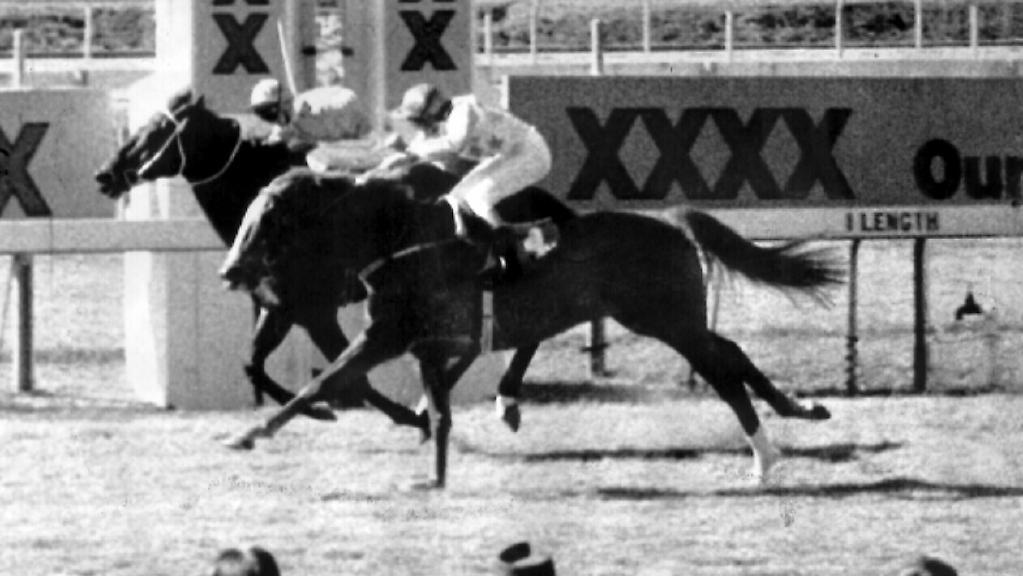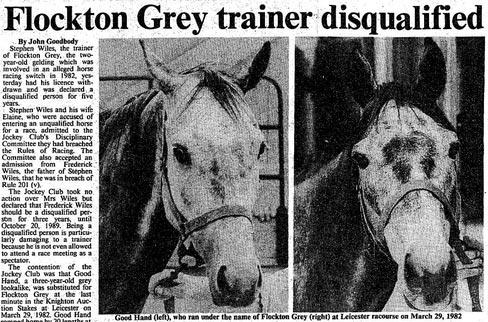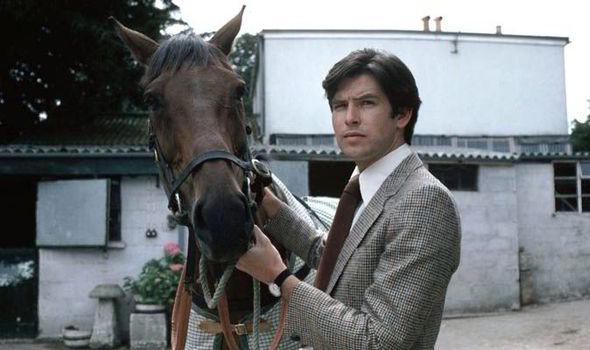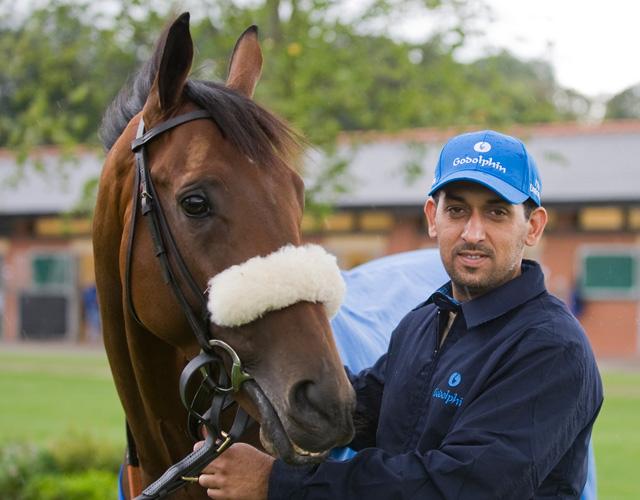betHQ
November 2, 2016
November 2, 2016
Horseracing may be known as the sport of kings, but it also attracts more than its fair share of attention from scoundrels.
A motley crew of jockeys, trainers, racehorse owners and bettors have all, at times, come up with inventive, and sometimes ludicrous, attempts to earn a quick buck off horseracing. Many of them have been caught red-handed too.
Here’s our pick of the biggest racing scandals in history.

No history of racing scandals would be complete without a mention of 1984’s Fine Cotton Affair. It wasn’t the biggest ring-in scandal in history, but it was definitely one of the most inept.
A betting syndicate headed by bloodstock agent, John Gillespie, attempted to substitute a horse of superior ability for a mediocre Australian racehorse by the name of Fine Cotton.
The syndicate’s plan started to crumble shortly after they got hold of a suitable looking “ringer” called Dancing Solitaire. The horse promptly fell ill.
Not to be deterred, Fine Cotton’s connections decided to replace Dancing Solitaire with a horse called Bold Personality. The fact that Bold Personality had different markings and coat colour to Fine Cotton didn’t put them off their plan either.
They responded to this challenge by attempting to dye Bold Personality a different colour using regular hair dye. When that failed, they settled for recreating Fine Cotton’s markings with paint.
Then they proceeded to put so much money behind “Fine Cotton” that the horse’s odds dropped from 33/1 to 7/2. This alone aroused the suspicion of race stewards.
Fine Cotton’s substitute proceeded to win the race by a narrow margin. Shortly thereafter, the paint began to drip off his coat. At this point, his trainer decided to flee the racecourse.
Six members of the betting syndicate responsible for the duplicity ended up copping lifelong bans from Queensland racing.
However, Gillespie later claimed that the scam had worked perfectly. According to the disgraced bloodstock agent, the syndicate had expected Fine Cotton to be disqualified. They had therefore put a big bet on the horse who was handed the victory when Fine Cotton was found out and disqualified.

Not all attempts to defraud racing are as amateur as the one involving Fine Cotton. One complex scam, which was foiled only at the last minute, was cooked up by a computer programmer, Chris Harne.
Harne worked for Autotote, which handles the majority of racing wagers in North America. In the course of his work, he picked up a number of potentially profitable vulnerabilities in the Autotote computer system.
Initially Harne focused on cashing in on tickets that had not been claimed by winning punters, which he realized he could re-print and claim at the racetrack.
To avoid detection, he recruited two university friends to cash re-printed tickets at racetracks around the United States. The trick worked, but Harne realized he and his friends would eventually be caught, given the large volume of winning tickets they were cashing in.
Harne soon unearthed an even bigger vulnerability in the Autotote system. He realized he could edit earlier selections for Pick 4 and Pick 6 wagers that had already been placed, provided he made the edits with two races left to go on bet. He could then back all the remaining horses in the two remaining races in the accumulator, guaranteeing a large payout.
Harne and his accomplices gave this scam a couple of successful dry runs before setting their sights on the Breeders Cup Pick 6.
Shortly before the Breeders Cup, the three conspirators placed Pick 6 bets on six high-profile races at the meeting. On race day, Harne went into his office, and after the fourth race, changed all the bets on his Pick 6 to winners. He then bet on all the horses in the remaining two races.
The plot worked, and the Pick 6 ticket generated over $3.1 million in winnings. However, the final race on the ticket, the Breeders’ Cup Classic, was won by 43/1 outsider, Volponi.
This win was so unexpected that Harne and his conspirators emerged as the only holders of a winning Pick 6 ticket. Needless to say, this attracted attention from authorities, who soon noticed that the winning ticket featured only one selection for the first four races, and then selected multiple horses for the remaining two.
The nature of the scam quickly came to light. Suspecting an inside job, investigators uncovered the connections between the conspirators, as well as Harne’s position at Autotote.
Under pressure from authorities, two of the conspirators confessed to the scam, and all three ended up serving time in jail, without seeing a cent of their winnings.

The UK’s most notorious ringer scam took place in a race at Leicester in 1982. The cast of this scandal included a gelding by the name of Flockton Grey, his owner Ken Richardson and an out-of-luck trainer, Stephen Wiles.
Richardson and Wiles hatched a plot to run a more accomplished three-year-old in place of Flockton Grey in a race for two-year-olds.
Good Hand, a horse previously owned by Richardson, was selected to substitute Flockton Grey and the two moved ahead with their plan. The next step in the plot involved placing £20,000 in bets on the 10/1 Flockton Grey at various betting shops.
The two fraudsters then sat back and waited for Good Hand to hand them a massive £200,000 windfall. Unfortunately for the pair, Good Hand proved to be even more overqualified for the race than they had anticipated, and secured victory by a whopping 20 lengths.
Bookies immediately refused to pay out the bet, and police were soon on the case. It was discovered that “Flockton Grey” had the teeth of a three-year-old, along with a scar on his foreleg that was missing from the horse investigators tracked down to Wiles’ stables.
Wiles was given a 25-year ban from racing, and Richardson was handed £45,000 in fines and legal fees, along with a suspended nine-month jail sentence.
This scandal turned out to be the launching pad for Richardson’s career as a fraudster. That career eventually ended with him copping a four-year jail sentence for attempting to burn down Doncaster Football Club to claim the insurance money.
Meanwhile, Flockton Grey spent four years in police custody. When he emerged, he was too old to race and instead became a popular retiree at a stable in Worksop, where he lived until the ripe old age of 28.

A more intricate plot was foiled in 1974 when an Irish betting syndicate almost pulled off a reverse ring-in.
The figures at the centre of this scandal were the racehorse Gay Future, trainer Antony Collins and the Irish multimillionaire, Tony Murphy, ably assisted by the members of an Irish betting syndicate.
Their plan involved substituting Gay Future with a lower quality horse ahead of a race. This would lead racehorse reviewers to underrate Gay Future’s prospects, bumping up his odds on race day. The betting syndicate would then put big money on their horse and walk away with a small fortune.
Wary of alerting authorities to their plot by loading a single horse with big bets, they took their scam a step further. They singled out two horses under their influence to bet into first and second favourites, ensuring Gay Future was only third favourite. This move also ensured that Gay Future wouldn’t run the race at short odds.
To ensure neither of these horses crashed Gay Future’s party, they’d both be withdrawn on race day. This would result in any bets on the two favourites being automatically transferred to the 3rd favourite – Gay Future.
To provide themselves with even more cover, the syndicate decided to take measures to prevent other punters from dropping the odds on Gay Future on race day, once he became race favourite. They hoped that this would avoid the sort of drop in price that might trigger an investigation.
To pull this off, they stationed accomplices at the course’s Tote who would prevent bets from being phoned in for Gay Future on the day of the race.
The plan worked like a charm. The mediocre Arctic Chevalier was presented to race reviewers in place of Gay Future, and they were appropriately underwhelmed. On race day, the top two horses in the betting were withdrawn from the race and their bets rolled onto Gay Future, who proceeded to demolish the field in his novice hurdles race, winning by 15 lengths.
Despite the careful preparations of Collins, Murphy and their accomplices, bookmakers sensed something fishy and refused to pay out winning bets before an investigation was held. Scotland Yard’s Serious Crimes Squad was put on the case and before long, the conspirators found themselves in court, facing charges of attempting to defraud bookmakers.
Remarkably, none of the perpetrators of the scam served any jail time. Collins was handed a modest £1,000 fine for his efforts.

Cycling isn’t the only sport where performance enhancing drugs are popular. In a sport where any sort of edge can make the difference, racing has had its fair share of doping scandals.
However, few expected one of the biggest stables in thoroughbred racing to be caught doping its horses. This is exactly what happened in 2013, when 11 horses from Godolphin Racing tested positive for banned anabolic steroids.
Trainer Al Zarooni was immediately implicated in the scandal, and found himself in hot water with both the British Horseracing Authority (BHA) and Godolphin’s founder, Sheikh Mohammed, the ruler of Dubai. It took just three days for the scrambling BHA to issue Al Zarooni with an eight-year ban, effectively ending his career as a trainer.
Zarooni claimed he had been unaware that anabolic steroids were illegal in the UK, stating confusion over the rules that allowed for their use in the United States.
As details of his activities emerged, it was discovered that 2012 St Leger Stakes winner, Ecke, and unbeaten filly, Certify, had been among the horses drugged by Zarooni. In turn, this cast doubt on the legitimacy of the major wins by other horses he had trained, including the 2011 winner of the 1,000 Guineas, Blue Bunting.
Godolphin emerged from the scandal relatively unscathed, thanks to the prompt response from the BHA. However, these events sparked a second doping scandal involving trainer, Gerard Butler, who also soon found himself on the receiving end of a five-year ban for using a variety of banned products on his horses.
These events served to cast doubt on the integrity of thoroughbred trainers and owners at the highest level, with some comparing the scandal to the Lance Armstrong doping scandal. The BHA has responded by introducing more frequent testing for banned substances and tightening up the laws surrounding their use.
When it comes to battles of the bookmaker heavyweights you won’t find a more […]
Rebel Betting is one of the oldest and best-known names in sports investment software, […]
Steeplechase horse racing is believed to have originated in Ireland in the 18th century. Huntsmen […]